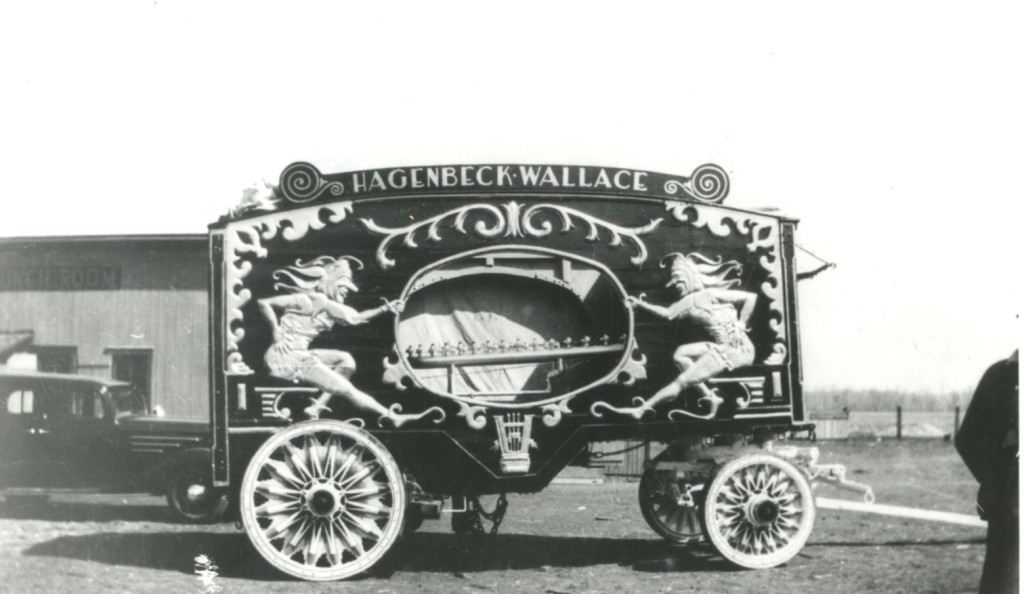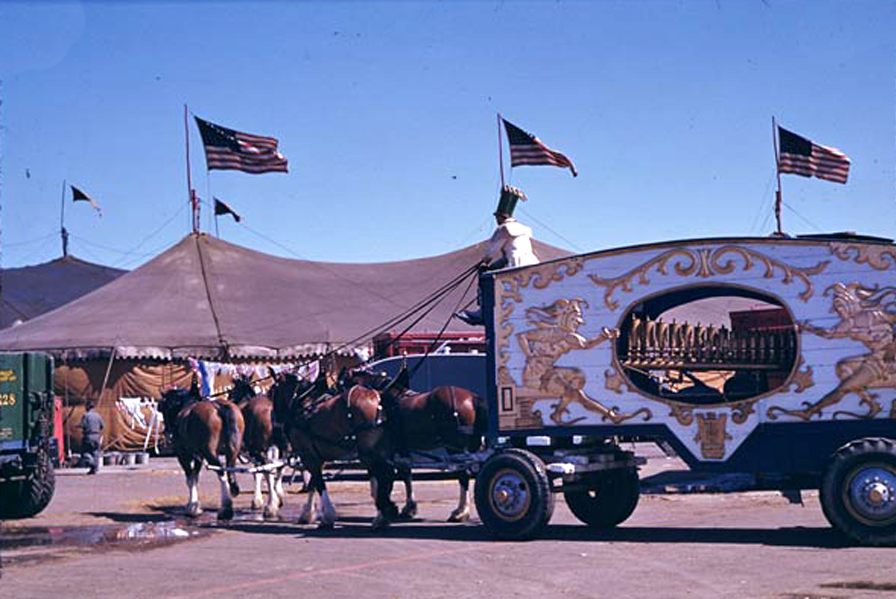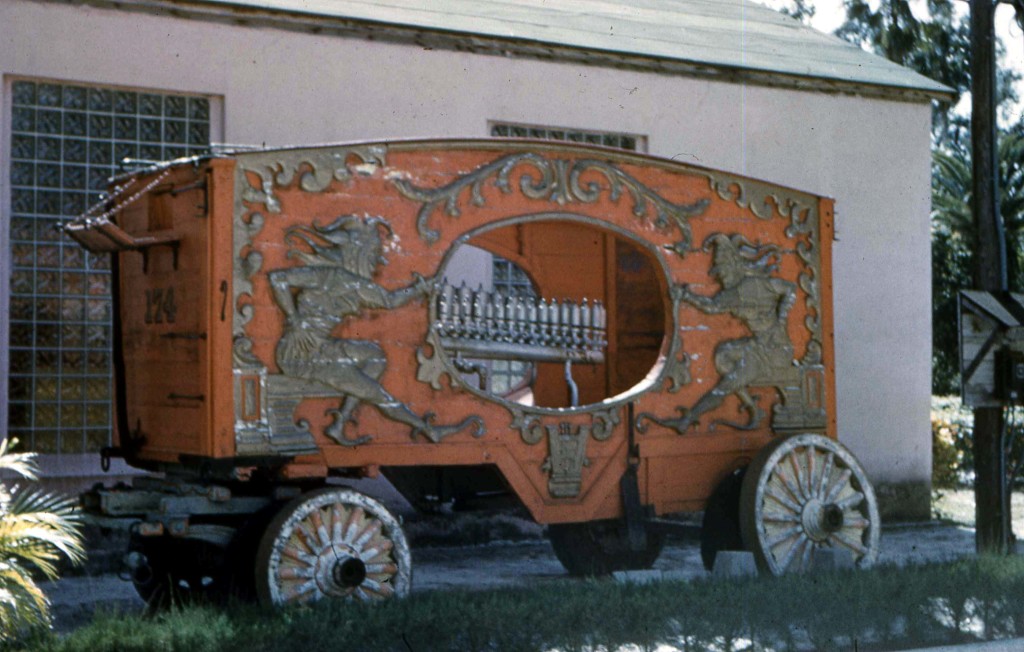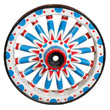Sells-Floto / Hagenbeck-Wallace Two Jesters Steam Calliope
by Joseph Bradbury
The wagon was built by Leonard Ainsworth and Charlie Luckie at the shows old quarters in Denver. Some confusion exists as to the date it was built. Charlie Luckie told me a few years ago that it was built the last winter the show spent in Denver, which would of course been the winter of 1920-21, but then again he mentioned H. B. Gentry who was the manager for Tammen and Bonfils, the Denver Post etc., and since he did I think perhaps the wagon was built a year earlier, winter of 1919-20. Reason for thinking that way is this – Jerry Mugivan and Bert Bowers purchased the circus following the 1920 season and went ahead and wintered the show in Denver, so actually if the wagon had been built the “last” winter in Denver it would have been built for Mugivan and Bowers instead of for Harry Tammen (Bonfils had died earlier). I strongly suspect that 1920 was the first season for the Two Jesters wagon but regret that I cannot present positive proof that was the case. Anyway it was built the period around 1920.
Since the wagon is so well known a good bit of fancy has developed concerning the carvings on the sides. Some have said that on one side of the carvings showing the “two jesters” that the actual figures came off a huge doorway to the Denver Post building. Several fans have checked into this, questioning old employees of the Post etc., but have never come up with any proof that such was the case. No old employees remember such a doorway with these carvings. Charlie Luckie personally told me a few years ago when he was on the King Bros. Circus that he and Ainsworth had built the wagon frame etc. and had a wood carver to do two of the carvings, but that the wood carver’s price was so high for the job, that they didn’t let the carver do the other two figures. Ainsworth and Luckie duplicated the figures for the other side of the wagon, and Luckie says if you examine the wagon closely you con tell that the carvings are not exactly alike, with one side showing much more artistic design than the other.The Two Jesters Calliope, as it later became called by fans and model builders in the mid-30’s when they started giving wagons “names” so that a system of identification could be used, served on Sells-Floto from the 1920 through 1925 season. Following the 1925 season the street parade was discontinued and the wagon was stored at Peru quarters from 1926 to 1932.
 ( 1934 – Conover Set # 807, photo # 410 – Don Smith Photo )
( 1934 – Conover Set # 807, photo # 410 – Don Smith Photo )
In 1932, Jess Adkins, who was then manager of the Ringling owned, Hagenbeck-Wallace Circus, decided to take the Two Jesters on the road to use it for lot concerts. In 1933 the calliope was also on Hagenbeck-Wallace for use in a few street parades that were given and also for lot concerts. In 1934 it was used in the famous Hagenbeck-Wallace street parade, one of the longest and most colorful of all times. In 1935 the show, now called Hagenbeck-Wallace and Forepaugh Sells Bros. Combined, discontinued daily parades but still gave a few at key dates using the calliope in those. In 1936 Hagenbeck-WaIlace did not tour but remained in Peru quarters.
For the 1937 season Edward Arlington and J. Frank Hatch leased the Hagenbeck-Wallace show from Ringling and put it on the road giving a daily parade. Arlington and Hatch made a small fortune in just a few weeks and then sold out to Howard Bary. Bary discontinued the street parade but the calliope was carried throughout the season for lot concerts etc.
In 1938 the calliope remained in Peru quarters and did not go out with Hagenbeck-Wallace. It remained there until the 1941 season when it was put on Ringling-Barnum to be used in the Spec. The wagon had been converted to rubber tired wheels by 1941. It was also repainted with a white body and gold carvings.

( Charles Cushman collection – 1341.10 – August 9, 1941 in Chicago – courtesy of the Indiana University Library Archives )
In 1942 and 1943 it was again used by Ringling-Barnum. In 1945 is was back on the show, and possibly it was carried in 1946. I’m not sure. It was stored in Sarasota quarters until 1949 when it was moved over to the Museum of the American Circus where it remains to this day. In 1956 it was completely restored and is in wonderful condition today. I don’t believe it is in playing condition but could be made so very easily.
 ( 1961 – at the Ringling Museums – Richard Cline photo )
( 1961 – at the Ringling Museums – Richard Cline photo )
Today the Museums are called the John and Mable Ringling Museums. The wagon can be seen there intact in the Circus Museums in all it’s wonderous glory. The biggest changes that occurred over the years were the numerous paint schemes that adorned this wagon. Many have been shown here to see some of those changes.
 ( 2006 – at the Ringling Museums – Bob Cline photo )
( 2006 – at the Ringling Museums – Bob Cline photo )
(1) Excerpts from the Circus Wagon File, Bandwagon, Vol. 2, No. 6 (Nov-Dec), 1958, pp. 3, 10
If you have any questions or have more photographic evidence, feel free to contact us at circuswagons@gmail.com
